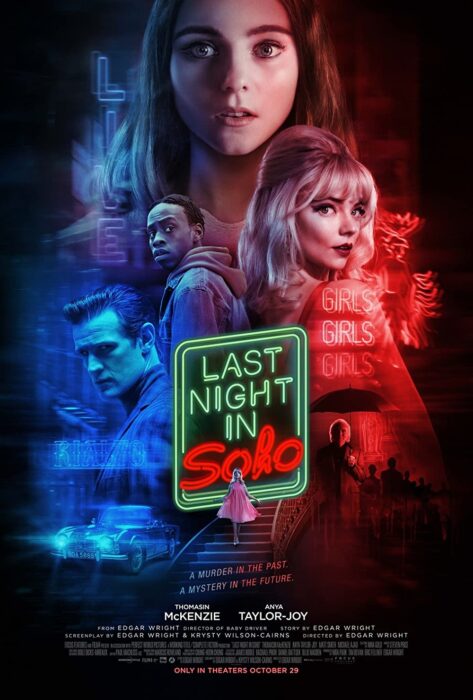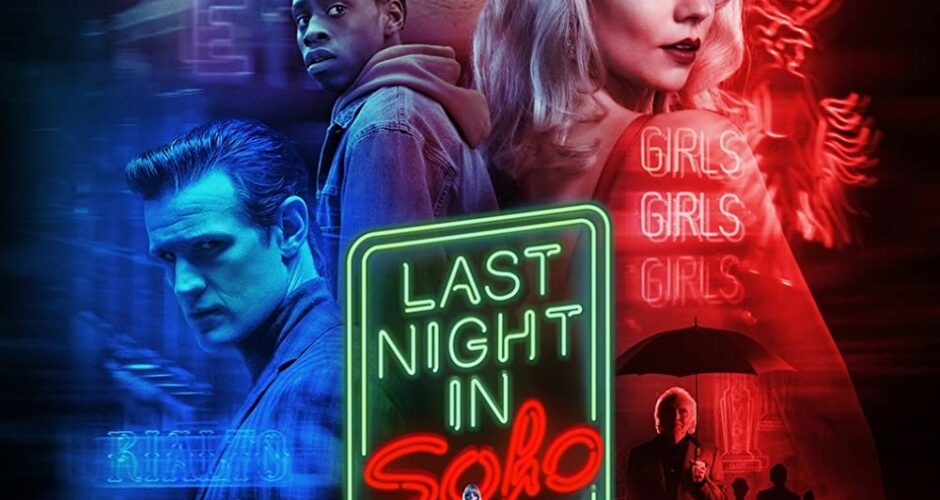
If you thought reading Lewis Carroll’s Alice in Wonderland was a trippy, mind-bending experience, wait until you see the British psychological thriller Last Night in Soho. Instead of falling down a rabbit hole, Eloise, aka Ellie (Thomasin McKenzie), a first-year student at the London School of Fashion, finds herself transported 60 years into the past – into the city’s vibrant Soho district during the swinging 1960s, Ellie’s favorite period of music and fashion.
Raised in rural Cornwall by her grandmother Peggy (Rita Tushingham), Ellie is a country mouse come to the big city, and Peg worries that Ellie’s dreams will crush her the way they did Ellie’s mother who, unable to handle the stress of the more cosmopolitan environment and her own failed dreams, committed suicide when Ellie was seven years old.
In London, Ellie rents the top-floor bedroom at the home of Ms. Collins (Dame Diana Rigg, superb as always, in her final screen performance), a strict, but not unkindly, landlady. “If I could live anywhere at all, it would be London in the ‘60s,” an excited Ellie tells her, in explaining the recordings of British pop divas Cilla Black, Dusty Springfield and Petula Clark that Ellie obsessively plays on her record player. Ellie falls asleep that night, only to find herself walking down a hallway that opens onto Piccadilly Circus, circa 1965. Brightly-colored neon signs light up the night, along with a giant movie marquee advertising the latest James Bond film, Thunderball.
Ellie, her eyes wide with amazement, crosses the street and enters The Café de Paris, Soho’s hottest nightclub. In the lobby, Ellie walks past a mirror but, instead of seeing her own reflection, a sexy blonde in a pink chiffon dress is staring back at her. This is Sandie (Anya Taylor-Joy), an impressively self-confident young woman who has come to London to pursue a singing career. When Ellie wakes up the next morning, she assumes the previous night’s adventure was all a dream. She soon realizes it’s a lot more complicated than that.
From that point on, the story shifts between past and present. Ellie seems to have a psychic connection with Sandie. So intrigued is she by Sandie that she dyes her own mousy brown locks blonde, which makes the two young women look almost like twins. She follows – or, really, parallels — Sandie wherever the latter goes, appearing as Sandie’s reflection in the mirrors that line the walls of the Café de Paris and other venues. Sandie hooks up with sleazy club manager Jack (Matt Smith), who promises to help her with her singing career but, instead, pimps her out to the creeps looking for sex at seedy men’s clubs.
The line separating the past from the present begins to blur even more and Ellie finds herself switching places with Sandie – as when Sandie is on the dance floor with Matt and, suddenly, Ellie takes her place. Soon the two women are appearing as separate individuals in the same scenes. Realizing the dangerous hole Sandie is sinking into, Ellie tries to save her. She becomes convinced that something terrible happened to Sandie at Ms. Collins’ house. The police think she is crazy. Only John (Michael Ajao), a sensitive classmate with a crush on her, accepts her story.
Director Edgar Wright (Baby Driver, Shaun of the Dead) has never made a film quite like Last Night in Soho. He and his co-screenwriter, Krysty [sic] Wilson-Cairns, have concocted a dark and increasingly disturbing fairy tale (marred slightly by a few cheesy bits late in the story). Thanks to Wright’s own vivid imagination and a supremely gifted team of collaborators, Last Night in Soho is also a cinematographic marvel. Most of the effects are achieved in-camera [filmed on the set during production, rather than added in Visual Effects in post-production, as is common). And, yes, the majority of the film is shot on celluloid, rather than digitally. The fantastic cinematography is by Chung-Hoon Chung (Old Boy, Lady Vengeance), who works in close collaboration with production designer Marcus Rowland to pull off seemingly impossible shots.
In many ways, Last Night in Soho is an homage to London’s swinging ‘60s and the music, stars and culture of that era. In addition to Rigg and Tushingham, Terence Stamp, another British actor associated with the ‘60s, plays a supporting role. Both McKenzie and Taylor-Joy are superb, playing very different characters than the ones that made them famous in Leave No Trace and The Queen’s Gambit. Here they prove yet again that they are two of the brightest actresses lighting up movie screens today.
